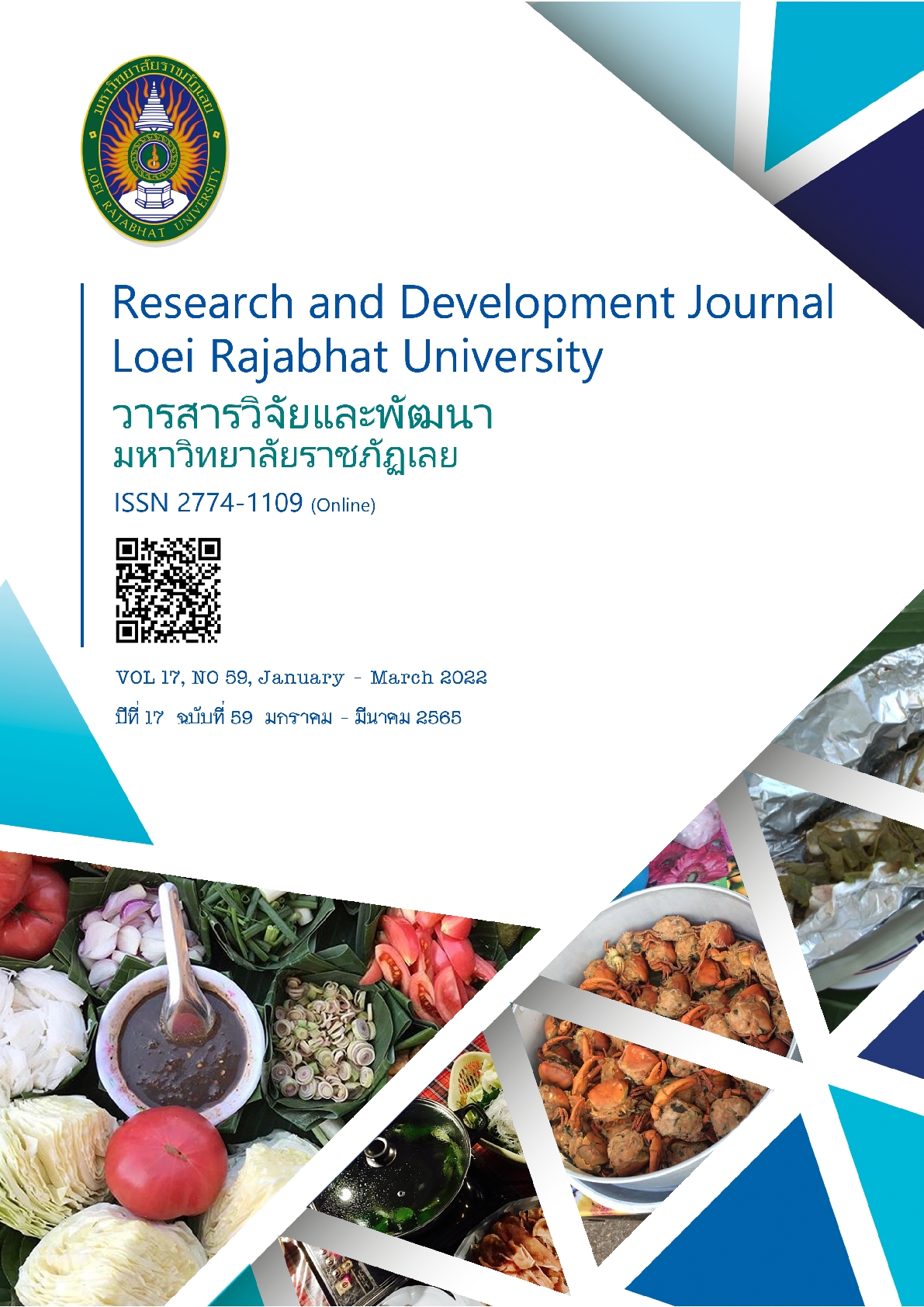Gastronomy Tourism Potential of Atsamart Community, Nakhon Phanom Province, Thailand
Keywords:
gastronomy tourism, local gastronomy, community-based tourismAbstract
The purpose of this research was to study the Gastronomy Tourism Potential of Atsamart Community by In-dept interviews and focus group discussion with the main informants which are government agencies, private sector and community leader. The result found that; The Pros of Atsamart Community Nakhon Phanom Province has the unique identity of Thai Sak Tribe which are living in the city area which is very comfort to go around. These community has an eating culture that relies on natural ingredients which are fresh and safe. The traditional and culture has been accepted by tourist. But in terms of areas that should be developed, it was image of the foods which has no identity to create the encouragement for the people in the area. The guidelines for developing the potential of food tourism are: To create a body of knowledge about the local food that is unique to the community, vegetables and herbs are available in the community for cooking and can build immunity for the tourists. To encourage the design of food packaging that is unique and reflects the identity of local communities along the Mekong River. Which the relevant should be encouraged to develop products, leading food tourism activities. The variety of ingredients, foods and cooking process by using the community ingredients as a main selling point. Training of Photography Technology and food reviews through online media to tell the story of the food tourism potential of the community may be able to provide tourists in the future.
References
กระทรวงการท่องเที่ยวและกีฬา. (20 กรกฎาคม 2561). แผนพัฒนาการท่องเที่ยวฉบับที่ 2 พ.ศ. 2560-2564. สืบค้นจาก https://www.mots.go.th/more_news.php?cid=312&filename=index
กระทรวงการท่องเที่ยวและกีฬา. (2560). รายงานภาวะเศรษฐกิจท่องเที่ยว. กรุงเทพฯ: กระทรวงการท่องเที่ยวและกีฬา.
กฤติยา แก้วสะอาด. (2564). ภาพประกอบสู่การสร้างสรรค์ผลิตภัณฑ์ของที่ระลึกกลุ่มชาติพันธุ์ลาวครั่ง. วารสารวิจัยและพัฒนา มหาวิทยาลัยราชภัฏเลย, 16(57). 1-9.
การท่องเที่ยวแห่งประเทศไทย. (24 กรกฎาคม 2560). Food Will Keep Us Alive. TAT Review. สืบค้นจาก http://www.etatjournal.com/mobile/index.php/menu-read-tat/menu-2017/menu-12017
ชมพูนุท ภาณุภาส, ปัญจพร ธนาวชิรานันท์ และ กิ่งกนก เสาวภาวงศ์. (2564). ศักยภาพการท่องเที่ยวเชิงอาหารตามอัตลักษณ์พื้นที่นครแม่สอด จังหวัดตาก. วารสารมหาวิทยาลัยคริสเตียน, 27(2), 46-61.
ญาณภา บุญประกอบ, จักรวาล วงศ์มณี, สิริพร เขตเจนการ และโยธิน แสวงดี. (2560). อาหารพื้นถิ่นกับกลไกในการส่งเสริมการท่องเที่ยวเชิงสร้างสรรค์: กรณีศึกษากลุ่มชาติพันธุ์ลาวครั่ง จังหวัดชัยนาท. วิทยาลัยดุสิตธานี, 11(ฉบับพิเศษ), 93-108.
พิมพ์ลภัส พงศกรรังศิลปะ. (2557). การจัดการการท่องเที่ยวชุมชนอย่างยั่งยืน: กรณีศึกษา บ้านโคกไคร จังหวัดพังงา. Veridian E-Journal, 7(3), 653-665.
ภัทรพร พันธุรี. (2558). การจัดกิจกรรมการท่องเที่ยวเชิงอาหาร โดยผ่านประสบการณ์ของนักท่องเที่ยวในประเทศไทย. เทคโนโลยีภาคใต้, 8(2), 27-37.
สริตา พันธ์เทียน, ทรงคุณ จันทจร และ มาริสา โกเศยะโยธิน. (2560). รูปแบบการจัดการท่องเที่ยวเชิงอาหารไทย โดยใช้แนวคิดเศรษฐกิจสร้างสรรค์ในเขตจังหวัด ลุ่มแม่น้ำภาคกลาง. วารสารวิจัยและการพัฒนา มหาวิทยาลัย นราธิวาสราชนครินทร์ สาขามนุษยศาสตร์และสังคมศาสตร์, 5(2), 184-195.
สำนักข่าวกรมประชาสัมพันธ์. (24 มิถุนายน 2561). จังหวัดนครพนมร่วมกับกระทรวงการท่องเที่ยวและกีฬา มหาวิทยาลัยศิลปากร สร้างชุมชนต้นแบบไทแสกโมเดลรองรับการท่องเที่ยวในพื้นที่. สืบค้นจาก http://thainews.prd.go.th/website_th/news/print_new/TNSOC61061400168
สำนักงานคณะกรรมการพัฒนาการเศรษฐกิจและสังคมแห่งชาติ. (2559). แผนพัฒนาเศรษฐกิจและสังคมแห่งชาติ ฉบับที่ 12 ปี 2560 - 2564. กรุงเทพฯ: สำนักนายกรัฐมนตรี.
Amir, A.F., Ghapar, A. A., A. Jamal, S., and Ahmad, K. N. (2015). Sustainable tourism development: A study on community resilience for rural tourism in Malaysia. Procedia-Social and Behavioral Sciences, 168(1), 116-122. doi: 10.1016/j.sbs pro.2014.10.217
Bertan, S. (2020). Impact of restaurants in the development of gastronomic tourism. International Journal of Gastronomy and Food Science, 21(1), 1-5. doi: 10.1016/j.ijgfs.2020.100232
Çalişkan, O., and Yilmaz, G. (2016). Gastronomy and Tourism. Global Issues and Trends in Tourism, Retrieved form https://www.researchgate.net/profile/Valentina-Albanese/publication/314594718_Opinion_Mining_to_Analyze_Perception_of_a_Touristic_Destination/links/58c398d6aca272e36dd04f11/Opinion-Mining-to-Analyze-Perception-of-a-Touristic-Destination.pdf
Guzel, B. and Apaydin, M. 2016). Gastronomy Tourism: Motivations and Destinations. Global Issues and Trends in Tourism. Retrieved form https://www.researchgate.net/publication/312914762_Gastronomy_Tourism_Motivations_and_Destinations
Herrera, C. F., Herranz, B. J., and Arilla, J. M. P. (2012). Gastronomy’s importance in the development of tourism destinations in the world. Madrid, Spain.: World Tourism Organization Retrieved form https://www.researchgate.net/publication/283579436_Gastronomy's_importance_in_the_development_of_tourism_destinations_in_the_world_Ref_Revista_Global_Report_on_Food_Tourism_AM_Reports_Volume_four_World_Tourism_Organization_UNWTO_2012_pp_6-9
Harrington, R. J., and Ottenbacher, M. C. (2010). Culinary Tourism: A Case Study of the Gastronomic Capital. Journal of Culinary Science & Technology, 8(1), 14-32. doi: 10.1080/15428052.2010.490765
Kivela, J. and Crotts, J. C. (2006). Tourism and gastronomy: Gastronomy's influence on how tourists experience a destination. Journal of hospitality and tourism research, 30(3), 354-377. doi: 10.1177/109634 8006286797.
Onur, N., and Onur, F. (2016). Potential of Gastronomy Tourism within Culture Tourism and Developing. Global Issues and Trends in Tourism, Retrieved form https://www.researchgate.net/profile/Valentina-Albanese/publication/314594718_Opinion_Mining_to_Analyze_Perception_of_a_Touristic_Destination/links/58c398d6aca272e36dd04f11/Opinion-Mining-to-Analyze-Perception-of-a-Touristic-Destination.pdf# page=479
Razzaq, A. R. A., Mohamad, N.H., A.Kader, S. S. S., Mustafad, M. Z. M., Ab.Hadi, M.Y., Hamzah, H. and Khalifah, Z. (2013). Developing Human Capital for Rural Community Tourism: Using Experiential Learning Approach. Procedia-Social and Behavioral Sciences, 93(1), 1835–1839. doi: 10.1016/j.sbspro. 2013.10.126
Sahin, G. G. (2015). Gastronomy Tourism as an Alternative Tourism: An Assessment on the Gastronomy Tourism Potential of Turkey. International Journal of Academic Research in Business and Social Sciences, 5(9), 79-105.
Sormaz, U., Akmese, H., Gunes, E., and Aras, S. (2016). Gastronomy in Tourism. Procedia Economics and Finance, 3, 725- 730. doi: 10.1016/S2212-5671(16)30286-6.
The World Tourism Organization. (2016). UNWTO Gastronomy Network Action Plan 2016-2017. Retrieved form https://webunwto.s3-eu-west-1.amazonaws.com/imported_images/46789/gastronomy_action_plan_print_2_es_web_0.pdf
TAT Review. (2018). Tourism Go Local ชุมชนเติบใหญ่ เมืองไทยเติบโต. สืบค้นจาก https://www.Tatreviewmagazine.com/article/tourism-go-local/
Lin, Y. C., Pearson, T. E., and Cai, L. A. (2011). Food as a form of Destination Identity: A Tourism Destination Brand Perspective. SAGE Journals, 11(1), 30-48. doi: 10.1057/thr.2010.2
Downloads
Published
How to Cite
Issue
Section
License
Copyright (c) 2022 Research and Development Journal, Loei Rajabhat University

This work is licensed under a Creative Commons Attribution-NonCommercial-NoDerivatives 4.0 International License.
ข้อความที่ปรากฎในวารสารฉบับนี้เป็นความคิดเห็นของผู้เขียนแต่ละท่าน สถาบันวิจัยและพัฒนา มหาวิทยาลัยราชภัฏเลย และกองบรรณาธิการ ไม่จำเป็นต้องเห็นด้วยและไม่มีส่วนรับผิดชอบใดๆ
สถาบันวิจัยและพัฒนา มหาวิทยาลัยราชภัฏเลย ขอให้ผู้อ่านอ้างอิงในกรณีที่ท่านคัดลอกเนื้อหาบทความในวารสารฉบับนี้






